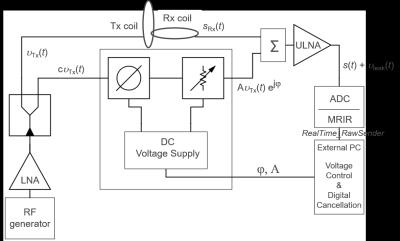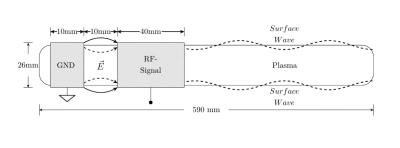Thursday, 27 April 2017
| Room 314 |
08:15 - 10:15 |
Moderators: Gang Chen, Fraser Robb |
Slack Channel: #s_int_eng_safety
Session Number: O86
08:15
 |
1047.
 |
In vivo MRI with Concurrent Excitation and Acquisition using Dynamic Analog Cancellation with Real-time Feedback 
Ali Özen, Jan Korvink, Ergin Atalar, Michael Bock
In this work concurrent excitation and acquisition (CEA) was realized in a clinical MRI system using a fully automated analog cancellation unit to suppress the unwanted transmit signal leakage during acquisition. The cancellation circuit is composed of a voltage-controlled phase shifter and attenuator, which changes phase and amplitude of a small copy of the transmit signal with a real-time feedback from MRI system. 90 dB on-resonant isolation was achieved within 2 s, where an isolation threshold was set to trigger re-adjustment of decoupling parameters when coil loading changes. To demonstrate feasibility, CEA MR data of a phantom and in vivo wrist were acquired.
|
08:27
 |
1048.
 |
Ratio-adjustable power splitters for array-compressed parallel transmission and RF shimming 
Xinqiang Yan, Zhipeng Cao, William Grissom
Array-compressed parallel transmission was recently proposed as a way to reduce the number of RF power amplifiers required for many-coil parallel transmission. This is achieved by connecting a large number of coils to a small number of channels via an array compression network that implements optimized coil-to-channel combinations using power splitters, attenuators and phase shifters. Previous array compression networks used tunable attenuators, but this resulted in significant power dissipation in the network. Here we propose novel ratio-adjustable power splitters (RAPS), which perform the combined duties of power splitting and attenuating, and will enable array compression networks with minimal power loss. The splitters could also be useful for RF shimming with a single amplifier, with the ability to tune the shims by adjusting transmission line lengths.
|
08:39
 |
1049.
 |
Improved uniformity of the spatial PSF for portable MRI using an optimized rotating magnet 
Clarissa Cooley, Jason Stockmann, Patrick McDaniel, Charlotte Sappo, Christopher Ha, Christopher Vaughn, Matthew Rosen, Thomas Witzel, Lawrence Wald
The development of a low-cost portable MRI scanner for brain imaging could facilitate imaging in new sites with insufficient space, power, or funding for traditional scanners. To address this need, we previously established a 3D encoding method using a rotating inhomogeneous B0 field and RF phase gradients, but uncontrolled field patterns showed encoding problems near the object center. Here we show this problem can be fixed in an optimized 122 kg head-sized permanent magnet with a built-in approximately linear encoding field in 2D images with improved resolution homogeneity across the field of view.
|
08:51
|
1050.
 |
Plasma antennas in MRI: A four-channel transmit-receive plasma array at 3T 
Markus Düring, Sebastian Außenhofer, Daniel Gensler, Cord Meyer, Andrew Webb, Peter Jakob, Florian Fidler
In this work a new type of antenna array based on plasma columns was designed, and the feasibility of using such an array for both transmit and signal reception was investigated. A four-channel plasma antenna array for a 3T whole-body scanner was designed and constructed. Images were successfully acquired for the first time, and negligible mutual coupling of the individual array elements was observed. Both acquired signal-to-noise maps and the acquired images show a great potential, particularly due to the absence of mutual coupling of the individual array elements.
|
09:03
|
1051.
 |
A Geometrically Adjustable Loop-Dipole (LD) Head Array for 10.5T 
Myung Kyun Woo, Russell Lagore, Lance DelaBarre, Byeong-Yeul Lee, Yigitcan Eryaman, Jerahmie Radder, Arcan Erturk, Gregory Metzger, Pierre- Francois van de Moortele, Kamil Ugurbil , Gregor Adriany
We designed a geometrically adjustable 16 channel transceiver head Loop-Dipole (LD) array which allowed for variation in element placement. Functionality was established without inter element decoupling circuitry. We simulated the resulting 16-channel LD array and compare to 8 channel dipole only and 8 channel loop only configurations. Finally we acquired in-vivo porcine images from a 10.5T whole-body imaging system to demonstrate principle functionality.
|
09:15
|
1052.
 |
Combined Transmit Array and 8-channel Receive Coil Array for 19F/1H for Human Lung Imaging at 1.5 T Utilizing MEMS Transmit-receive Detuning 
Adam Maunder, Madhwesha Rao, Fraser Robb, Jim Wild
MRI of inert fluorinated gases is a developing method for pulmonary ventilation imaging, but image quality is constrained by low spin density. Additionally, proton imaging is desirable for complementary structural information from the lungs. Here, an 8-element transmit/receive coil array for 1.5 T is presented, which is capable of imaging both 19F and 1H nuclei with higher SNR when compared to single-element alternatives. Microelectromechanical systems (MEMS) switches are utilized to provide broadband transmit-receive isolation over the frequency range of both nuclei. Coil channel isolation is demonstrated and MEMS switching performance with phantom imaging of both nuclei.
|
09:27
|
1053.
 |
Size-adaptable 13-channel receive array for brain imaging in human neonates at 3 T 
Nibardo Lopez Rios, Alexandru Foias, Gregory Lodygensky, Nikola Stikov, Mathieu Dehaes, Julien Cohen-Adad
A size-adaptable receive array that can accommodate a variety of heads in a pediatric population (27-week-premature to 1.5-month-old) is proposed. Thirteen spherically distributed loops can move in radial and axial directions to maximize their proximity to the subject. Decoupling between elements is ensured by strong preamplifier decoupling (-27 to -33 dB). Tests on a scanner with two phantoms (8 and 10 cm in diameter) resulted in higher SNR with the proposed coil compared to 8-Ch and 32-Ch commercial head coils. The method restricts head motion and could be of interest for other size-varying body parts, such as breast and limbs.
|
09:39
|
1054.
 |
A 16 channel head-only pTX array using high efficiency in-bore RFPAs at 3T 
Michael Twieg, Bhairav Mehta, Simone Coppo, Jan Ruff, Rene Gumbrecht, Mark Griswold
Parallel transmit (pTX) has been proposed as a solution to flip angle inhomogeneity and SAR at ultrahigh fields, as well as safety hazards with implantable devices. However, pTX systems come at high cost, partially due to the use of remotely located linear RF power amplifiers (RFPAs), which have poor power efficiency and rely on costly RF power cables to couple power to the subject. Here we demonstrate a 16 channel transmit array utilizing high efficiency RFPA modules inside the scanner bore. They RFPAs can deliver a total of over 1kW to the array while only cooled by natural convection.
|
09:51
|
1055.
 |
COSI Transmit: Open Source Soft- and Hardware Transmission System for traditional and rotating MR 
Christian Blücher, Haopeng Han, Werner Hoffmann, Reiner Seemann, Frank Seifert, Thoralf Niendorf, Lukas Winter
As part of the open source imaging initiative (www.opensourceimaging.org), a collaborative effort to build an open source MRI, we proposed and built a transmission/reception RF system mostly consisting of open source components for traditional and rotating spatial encoding schemes. COSI Transmit is based on a GNU Radio compatible software defined radio (SDR) as a spectrometer, a 1kW RF-power amplifier, T/R switch, low noise preamplifier and a transmit/receive solenoid RF coil. The system operates in the frequency range from 1.8-30MHz (B0=0.042-0.7T) and can potentially be extended to B0=1.27T. Material cost of the system is ~3000€.
|
10:03
|
1056.
 |
Correction of Gradient Induced Clock Phase Modulation for In-Bore Sampling Receivers 
Jonas Reber, Josip Marjanovic, Christoph Schildknecht, David Brunner, Klaas Pruessmann
With increasing receive channel counts, moving digitizer electronics close to the coil is desirable for reduced cabling and cable coupling and improved patient safety. However, gradient induction degrades in-bore operated circuit performance. Particularly vulnerable are high quality sampling or mixing clocks, required for digitization or demodulation. Gradient induced oscillator modulations add to the already stringent jitter requirements and therefore directly reduce SNR. We present a method which corrects large parts of clock modulations and therefore increases phase SNR of in-bore acquired data e.g. 18 dB for a sinewave corrupted by EPI gradients.
|
|












